Add Obi-Strips to your cassette or CD releases! Starting from CAD$49.
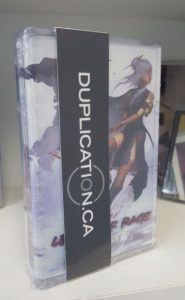
An Obi-Strip is a piece of printed paperboard wrapped around a cassette or CD. Obi-strips are common on Japanese releases. The term obi refers to the sash wrapped around a kimono.
Add Obi-Strips to your cassette or CD releases! Starting from CAD$49.

An Obi-Strip is a piece of printed paperboard wrapped around a cassette or CD. Obi-strips are common on Japanese releases. The term obi refers to the sash wrapped around a kimono.
Every cassette deck runs at a slightly different speed. The tolerance of a machine made in 1990 when brand new was 0.5% to 2%. After 25+ years, it is pretty sure that your 25 year old machine needs new belts and a speed calibration. An exception could be made for machines with direct drive capstan motors. Very few machines had direct-drive capstans because they were very expensive.
How to adjust the speed of cassette decks
Many cassette decks have a hole in the back of the capstan motor. This hole is usually covered by a rubber shroud, and you can insert a small jeweler’s screwdriver to connect with a potentiometer which allows adjustment of the speed. This adjustment is often very sensitive and it’s difficult to get a very precise and stable speed – a very small adjustment can result in a huge speed variance. Better decks might have an adjustment potentiometer on the PC board which allows a much more precise setting of the speed.
We offer a test tape containing a 440Hz A tone and a 3150 Hz tone to assist in setting the speed of your cassette deck.
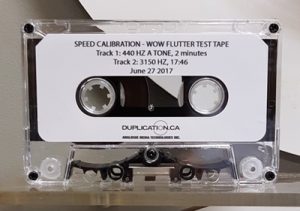
https://www.duplication.ca/shop/audio-cassette-speed-calibration-test-tape.html
Many of our cassettes are made without the record-inhibit tabs! If you have a professional duplicator that won’t be an issue because pro duplicating machines do not check for the record tab. But home recording decks will not record on tabs out cassettes. Fortunately, it isn’t too difficult to fool your cassette deck so it records even when the tabs are out.
Method 1: put scotch tape over the hole on the top of the cassette.
Method 2: put duct tape in the upper left corner of the cassette well to block the pin from coming down.
Method 3: Open the cover and find a way to stop the pin from going down, or short-circuit the contacts on the sensor. A toothpick or wire can be used to keep the pin up.
If you’ve modified your cassette deck, just don’t forget that it will now record on any cassette even if the record tabs have been punched out.
In another post we discussed how to record on high bias tapes in normal bias shells. One issue is to have the proper playback EQ so the person listening to your tape won’t find it too dull nor too bright. Many cassette decks have a button to choose either 70 (chrome) or 120 µS (normal) EQ on playback, but this button was done away with on many later generation decks.

Tape EQ selector
High bias tapes are traditionally recorded with 70 µS EQ. If you play them back with 120 µS EQ they will have a 4.5 dB high frequency boost .
If you cannot choose the recording EQ on the machine you can adjust the audio input by applying a high-shelf EQ filter to cut 4.5 dB:
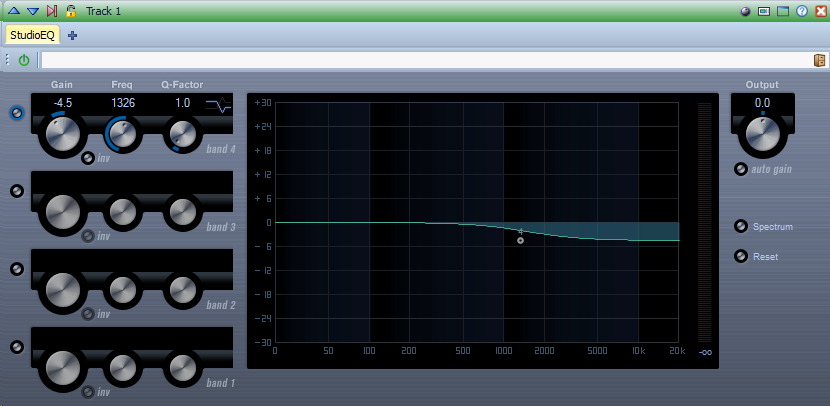
EQ compensation when recording high bias tapes with 70 microsecond chrome EQ but playback will be at 120 microsecond normal EQ
Cassette tapes come in several types:
Many clients buying blank tapes want high bias tape loaded into the funky coloured cassette shells. Here’s some background info and an explanation of the challenges you have to overcome.
In the early days of cassettes the tape hiss was quite bad. Chrome tapes had less hiss and a much greater ability to handle high frequencies, but the tape engineers decided to change the EQ curve from 120 µS to 70 µS (microseconds) to give an additional 4.5 dB reduction in tape hiss instead of better high frequency performance. That was great for classical music but not much use for high energy rock and electronic music. With improvements in tape and the advent of Dolby B which gave a 10dB reduction in hiss, the engineers regretted the move to 70 us EQ.(1)
The EQ used to record and playback can be separate from the recording bias, as on many Nakamichi decks we’ve seen – on this model we can choose Type II bias and 120 µS EQ:

Bias and EQ buttons on tape recorder
On some models there is no separate EQ button and the recording will be with 70 µS EQ if you use Type II high bias.
Some cassette decks have no buttons and instead use sensors which detect notches on the top spine of the cassette:
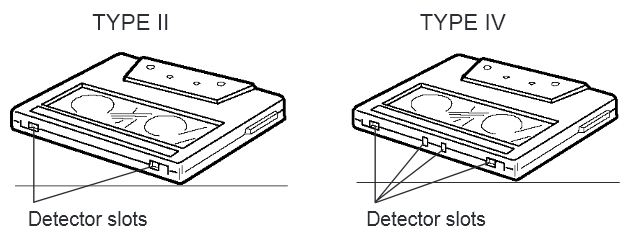
Tape Bias and EQ detector slots
Then there are the record-inhibit tabs which you can knock out to prevent accidental erasure. All the funky colours come with the tabs already knocked out, saving the duplication company a lot of labour.
If you want to use Type II tapes in coloured Type I shells you have to overcome several challenges:
1 Terence O’Kelly, “EQ”, The Inventor’s Notebook, Technical bulletin #4 (BASF technical bulletin)
10% Discount on CD/DVD Pressing and Duplication
We’re so happy we’ve been able to gain so many new cassette clients across North America! As a special Thank-You we’re offering a 10% discount on our CD pressing and CD duplication services (DVD too) to all our cassette clients. If you’ve ordered any cassettes (blank or duplicated) from us since 2013 you qualify for the discount. The offer is valid until March 31, 2016.
Terms: discount applies to regular pricing with standard turntime for quantities of 50 to 5000 pieces.
CD Duplication with Carboard Jackets Calculator
CD Duplication Bulk or and Paper and Plastic Packaging
Mention coupon 10FORCD2016 to your rep for the 10% discount.
(Only 1 coupon can be redeemed per order)
Tascam made the popular Portastudio 4 track cassette recorders. Clients often ask us what tapes should be used with these machines. Well first of all, you need the record tabs to be IN so look for tabs in cassettes (C0-TI). Once you have your final mix you would punch out the record tabs to prevent accidental erasure. The 414 and 424 machines need high bias tapes like TDK SA, Maxell XLII, or BASF Chrome Plus. These tapes came in C-60 and C-90 formats. The C-60 tapes are preferred for the thicker base film and slightly better overall performance. Keep in mind these Portastudios run at double speed (3.75 inches per second) and record all 4 tracks in one direction, so a 60 minute tape only gives you 15 minutes of recording time.
The Portastudios used a propietary track format laying down all 4 tracks with even spacing between all tracks. Regular cassette decks have a larger space between the A and B side, and a narrower gap between the left and right channels of each side. Here’s an illustration from Tascam’s manual:
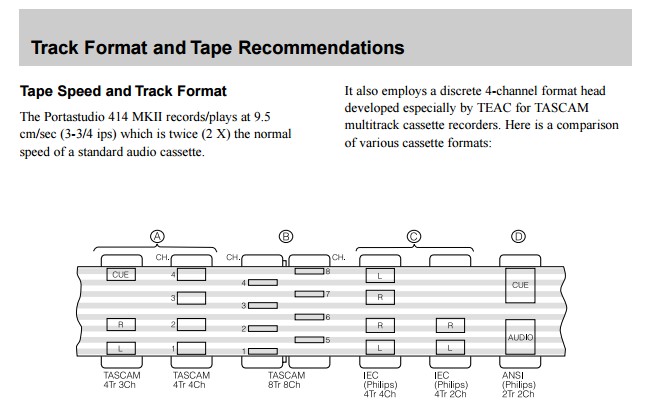
Tascam Portastudio cassette track widths
Tape recommendations
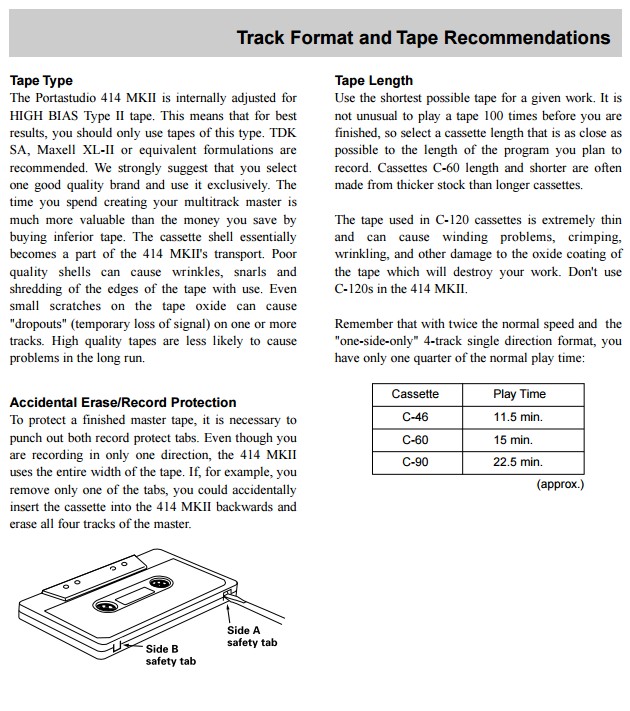
Tape recommendations for Tascam Portastudio 414 and 424
A new colour for your 2016 tape projects – butterscotch / camel cassettes! A great colour that goes well with all sorts of artwork. These cassettes also feature a swank brick pattern and debossed A/B side markings. The record tabs are OUT so if you’re recording on home cassette decks you need to put scotch tape over the holes.
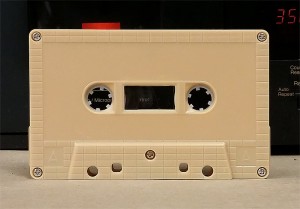
Butterscotch / camel cassettes with brick pattern